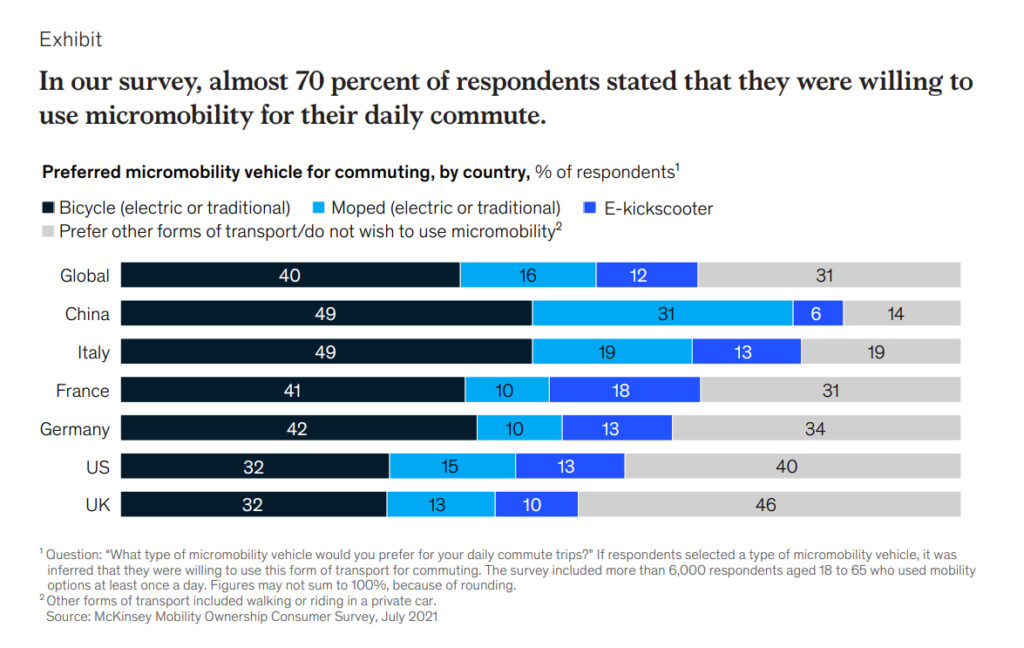A new McKinsey survey suggests that consumers are open to micromobility solutions, but their acceptance will vary by country.
Respondents to the Mobility Ownership Consumer Survey, conducted by the McKinsey Center for Future Mobility were enthusiastic when asked if you could ride a bicycle, moped or electric scooter to work, would you do it?
Nearly 70% said they would be willing to use micromobility vehicles to commute to work, including bicycles and mopeds that can be traditional or electric.
These results suggest that a growing number of workers may shift toward smaller, environmentally friendly forms of transportation as pandemic restrictions are lifted and offices reopen.
According to Mckinsey, the findings are in line with its earlier research from 2020, which suggested that micromobility was poised to make a strong comeback as the COVID-19 pandemic wanes and people begin to travel more.

Non-uniform distribution
The consultant’s survey also revealed that the adoption of micro-mobility is far from uniform due to location-specific factors. The willingness to use small vehicles is highest in countries with a long tradition of micromobility, such as Italy (81%) and China (86%).
At the other end of the spectrum, only 60% of U.S. respondents said they would consider micromobility, perhaps because they have traditionally relied on private cars or public transportation for their commutes, and the sight of zigzagging through traffic on a moped or scooter is relatively rare.
In general, respondents prefer bicycles, which offer greater range and better storage space than e-kickscooters and a lower price than mopeds, although there are exceptions:
- Mopeds are especially popular in China, where authorities do not require drivers to have a license or insurance for vehicles with a maximum speed of 25 kilometers/hour.
- Respondents from the United Kingdom and China were the most reluctant users of e-kickscooters, possibly because those countries either banned them for safety reasons or recently approved them.
- Consumers in the U.S., France and Germany, which have established ride-sharing systems, were more open to e-kickscooters, a trend McKinsey says is not surprising, as any vehicle that is available through a ride-sharing service tends to experience an increase in private purchases.
Different implications
The results of the McKinsey survey have implications for the various companies within the micromobility sector, and as it indicates, also for their prospects for success. Let’s take a look at the suggestions in the consulting firm’s report:
Shared mobility providers
Because micromobility preferences vary by geography, shared mobility providers need to be aware of the local transportation habits of any city or region in which they wish to operate.
Typically, providers first choose the cities in which they want to operate and then examine local preferences to determine which modes of transportation will be most in demand. At some point, they may expand their product portfolio, for example, by adding mopeds to the bicycle options in certain locations.
While this expansion could win them new business, their capital expenditures will increase. A combined fleet, where vehicles have different maintenance requirements, charging needs and life cycles, will also increase strategic and operational demands.
Cargo and parking operators
This group can offer charging and parking solutions suitable for various modes of micromobility. In addition to increasing demand for their facilities, a comprehensive approach will help cities minimize the number of vehicles parked on the streets and optimize the use of these modes of travel.
Public transport operators
To facilitate point-to-point travel, public transport operators can provide dedicated space on buses or trains to store several micromobility vehicles.
This strategy will also help increase the customer base of public transport and micromobility operators.
Cities
When selecting a shared micromobility service provider, cities should favor companies that have a broad product portfolio and truly understand local mobility needs.
They can also promote the growth of micromobility by installing driving, parking and charging infrastructure that integrates multiple modes, and also facilitates transportation for pedestrians and other commuters.
Regulators can help by creating safe mobility corridors for all forms of transportation. However, they must first ensure that they have public support from all those who regularly commute to their location.
Written by Antonio Vilela




